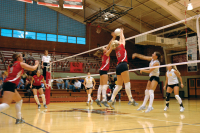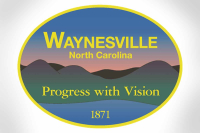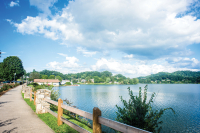Christmas tree industry growing strong
 With more than 25 million real Christmas trees sold in the United States every year, growing Christmas trees is a thriving industry for farmers in North Carolina.
With more than 25 million real Christmas trees sold in the United States every year, growing Christmas trees is a thriving industry for farmers in North Carolina.
SEE ALSO:
• A real tree takes real work
• The art of picking the perfect Christmas tree
• Christmas tree farm experience
“I think real trees are holding their own,” said Tom Sawyer, owner of Tom Sawyer Christmas Tree Farm in Cashiers. “There’s been more of a resurgence of people lately who want the real deal.”
Growing any crop comes with risk, because the success rate depends on weather conditions, the quality of seeds and the ability to sell the crop once it’s ready to harvest. Luckily, real Christmas trees are still in high demand.
“It’s the centerpiece of people’s holiday,” said Jennifer Greene, executive director of the North Carolina Christmas Tree Association. “Whether they scale back on size or not — which we did see for a couple of years — people who are real tree buyers are pretty faithful to that because it’s a tradition.”
Related Items
Supply and demand
Many of the tree farmers in Western North Carolina say they have had great sales this year, and Greene said that is the general consensus of farmers statewide. While there was a large oversupply of Christmas trees nationwide several years ago, she said the number of trees being grown now has come back down.
“There are patterns of fluctuation just like any crop, but unlike cabbage or cattle, Christmas trees have an eight-year growing cycle so it takes a while to see the patterns in the industry,” Greene said.
Brian Boyd, owner of WNC Christmas Tree Farm in Waynesville, said finding enough seedlings for planting each year is becoming more difficult because of the big surplus growers experienced probably about eight years ago.
“Seedlings are hard to come by. A lot of growers have to place their order a couple of years ahead,” Boyd said. “The overabundance pushed out a lot of the guys who were growing seedlings so now it’s created a shortage.”
Boyd said he’s been able to order some seedlings from places in North Carolina, but he also had to order some from Michigan to have enough for his annual planting of about 2,000 trees. He prefers local seedlings because Fraser firs are native to North Carolina terrain and weather.
“I’d rather get them all from North Carolina because Fraser firs seedlings are more acclimated to this area,” he said. “They have more snowfall up North so the seedlings are coming from areas still covered in snow during our springtime, which creates stress for them.”
Don Nesbitt, owner of Nesbitt Christmas Tree Farm in Clyde, said the most recent glut of Christmas trees did have a negative impact on his farm for a couple of years. Farmers had to sell more of their trees wholesale and at a much cheaper price to be able to move them all. The cheaper wholesale prices were more appealing for shoppers than paying more to cut one down themselves on the farm.
“But right now it’s to the point where tree prices are pretty competitive again — there’s not an overabundance of them, so that tells me there must be a huge demand for them again. Hopefully that means more people will start planting more seedlings.”
Season coming to an end
Even with a couple of weeks to go until Christmas Day, many of the tree farms are already closed for the year. They may have some pre-cut trees available, but choose and cut is no longer an option.
Nesbitt Christmas Tree Farm is closed for the season. Nesbitt said he plants only about 8 acres of Fraser firs and sells between 500 to 700 each year.
“Since we had such a good year, we decided to close down so we’ll have enough trees for next year,” he said.
David Boyd, owner of Boyd Mountain Christmas Tree Farm just down the road, has a much larger operation each year. With more than 4,000 trees sold this year, he had to end the choose and cut on the farm on Dec. 10 — much earlier than usual. Boyd said the farm usually stays open seven days a week during the season, but this year he scaled it back to just weekends and still sold out in a few weeks.
Nesbitt agreed that people are buying their Christmas trees earlier and earlier each year. While locals still seem to be buying their trees closer to Christmas time, Nesbitt said Thanksgiving week is the busiest time. Families from South Carolina, Georgia, Florida and Tennessee traveling to and from the area to see family for the holidays tend to pick up a tree to take home with them.
Sawyer has seen the same trends. While things are now slowing down at his farm, there is still a selection of choose and cut trees as well as pre-cut trees. He could sell most of the trees on the farm this year, but any experienced tree farmer knows you have to keep so many of the 5- and 6-footers so you’ll have enough 7- and 8-footers for next year’s season.
Boyd said his tree farm — WNC Christmas Trees — will be open this weekend for choose and cut, but then he will be about cleared out of his 7- and 8-foot trees as well. He doesn’t have a final count but estimates he’s sold more than 700 this year. He said he thinks he’s benefited this year because so many of the larger farms sold out early. Many locals who have waited to buy their trees are coming to his farm to find one.
“The farmers in the area all try to help each other out. If I’m running low I try to help them out by sending people down to Boyd’s if they’re looking for a bigger tree and vice versa,” he said. “We’re all in competition, but we try to help each other out.”
Why buy a real tree?
The North Carolina Christmas Tree Association is a nonprofit organization with the mission of representing its 250 members while educating the public about why they should opt for a real Christmas tree over an artificial tree.
Some people don’t see the need to cut down a real tree when they can purchase an artificial tree they can keep for 10 years or more. Greene responds to that by reminding people that Christmas trees are an agricultural crop grown for the specific purpose of being harvested.
“When you buy a real tree, you’re buying an American-grown product,” she said. “Most artificial trees are produced in China and pollution occurs during that process. They are also made with non-biodegradable plastics.”
Even if a family uses an artificial tree for 20 years, Greene said the tree would still end up in a landfill at some point. A real tree, on the other hand, is recyclable and for every tree harvested, a farmer plants three more seedlings in its place to start the growing process all over again.
Sawyer agreed that cutting down a real Christmas tree is not the same as cutting down a random tree in the woods. Not only are Christmas trees recyclable and renewable, but also Sawyer said they are good for the environment because of the amount of oxygen they produce. One acre of trees produces the daily oxygen requirement for 18 people.
“When you come to the mountains you smell fresh air but what you’re really smelling is the fresh oxygen they produce,” he said.
Brian Boyd said there are plenty of uses for a Christmas tree after the holiday season. His farm sells trees with the root ball so that people can replant them after the holiday. Trees can also be thrown in the woods to be used for bird habitats or in a lake to be used as a fish habitat.
Greene said the bottom line is that buying a real Christmas tree helps support American farmers, many of whom grow trees on the side to generate additional revenue for the rest of the year.
“It generates revenue that is distributed around the community through real estate taxes, income taxes and sales tax,” Sawyer said.
North Carolina Christmas tree facts
• North Carolina has about 1,300 growers producing Fraser fir trees on 40,000 acres.
• Fraser fir represents more than 98 percent of all species grown in North Carolina.
• Fraser fir is grown in Western North Carolina.
• The North Carolina Christmas tree industry is ranked second in the nation in number of trees harvested and cash receipts.
• North Carolina produces more than 19 percent of the real Christmas trees in the U.S.
• The North Carolina Fraser fir Christmas tree is the most popular Christmas tree in North America and is shipped into every state in the U.S. as well as the Caribbean Islands, Mexico, Canada, Bermuda, Japan and other points all over the world.
U.S Christmas tree purchase figures (in millions)
2008 2009 2010 2011 2012 2013 2014
Real 28.2 28.2 27 30.8 24.5 33.02 26.3
Fake 11.7 11.7 8.2 9.5 10.9 14.7 13.9
What the numbers mean
The 2014 figures show that consumers in the U.S. purchased 26.3 million farm-grown Christmas Trees. Many factors can influence total trees purchased, including trees available for harvest, harvest conditions, weather conditions, number of consumers traveling for the holidays, number of retail outlets offering trees for sale and even the number of days between Thanksgiving and Christmas.
Source: National Christmas Tree Association









